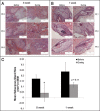Temporal changes in gene expression in the skin of patients treated with isotretinoin provide insight into its mechanism of action
- PMID: 20436886
- PMCID: PMC2835911
- DOI: 10.4161/derm.1.3.8258
Temporal changes in gene expression in the skin of patients treated with isotretinoin provide insight into its mechanism of action
Abstract
Isotretinoin (13-cis RA) is the most potent agent in the treatment of acne. Insights into its mechanism of action can lead to drug discovery of alternative compounds with comparable efficacy but improved safety. The goal of this study is to compare the temporal changes in gene expression in the skin of acne patients after 1 week and 8 weeks of treatment with isotretinoin. Microarray analysis was performed on skin biopsies taken from eight acne patients prior to and at 8 weeks of treatment with isotretinoin. Results were compared with data obtained from seven acne patients biopsied at one week of treatment in a prior study. Distinctly different patterns of gene expression were noted. At 8 weeks, genes encoding extracellular matrix proteins were upregulated and numerous genes encoding lipid metabolizing enzymes were downregulated. At 1 week, genes encoding differentiation markers, tumor suppressors and serine proteases were upregulated. Only three genes were commonly downregulated. The temporal changes in gene expression in patient skin noted with isotretinoin substantiate many previously reported effects of isotretinoin and other retinoids, suggesting a model wherein isotretinoin induces apoptosis leading to reduced sebaceous gland size, decreased expression of lipid metabolizing enzymes and increased matrix remodeling during acne resolution.
Keywords: 13-cis retinoic acid; acne; sebaceous gland.
Figures




References
-
- Goldstein JA, Comite H, Mescon H, Pochi PE. Isotretinoin in the treatment of Acne. Arch Dermatol. 1982;118:555–558. - PubMed
-
- Picton W, Clark C. The effect of various treatments on the size of sebaceous glands of hairless mice and hairless hamsters. Br J Dermatol. 1977;96:277–282. - PubMed
-
- Hoglund P, Haila S, Socha J, Tomaszewski L, Saarialho-Kere U, Karjalainen-Lindsberg M-L, et al. Mutations of the Downregulated in adenoma (DRA) gene cause congenital chloride diarrhoea. Nat Genet. 1996;14:316–319. - PubMed
-
- Makela S, Kere J, Holmberg C, Hoglund P. SLC26A3 mutations in congenital chloride diarrhea. Hum Mutat. 2002;20:425–438. - PubMed
Grants and funding
LinkOut - more resources
Full Text Sources
Molecular Biology Databases
